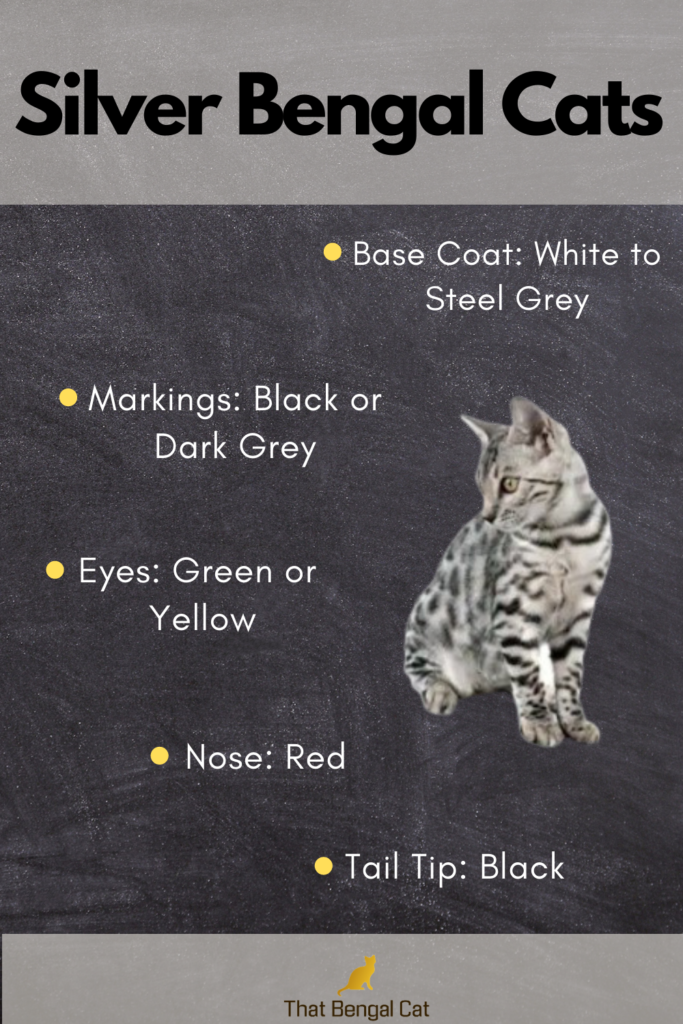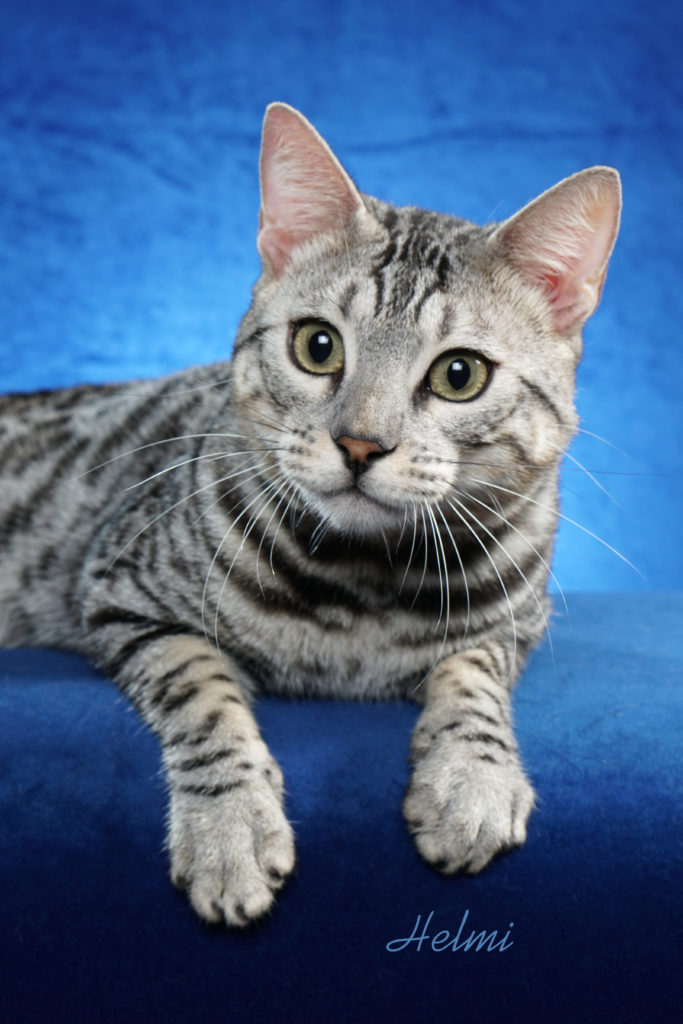In this article, we’re going to look at all aspects of silver Bengal cats.
When researching the different colours and patterns to be found in the Bengal breed, it can be hard to determine what exactly defines a silver Bengal.
Plus there are questions relating to size and cost of a silver Bengal kitten when comparing to the more common brown.
This guide will answer those questions (and more) and will leave you well placed to understand exactly what a silver Bengal cat is.
Topic Overview

When looking for a Bengal cat, you may have comes across striking looking specimens with silvery steel-like fur contrasted against jet black markings.
These may well have been silver Bengals, a relatively new addition to the breed.
But they are not simply one ‘type’ of cat.
No, due to the way which the gene that produces the silver look works, it’s possible to create all manner of colour combinations as we shall see.
First though, let’s take a look at how they came to be…
How Silver Bengal Cats Were Created
Bengal cats have developed considerably since the original cross between a domestic cat and the Asian Leopard Cat.
Silver didn’t start appearing as a base coat colour in the Bengal breed until the 1990s.
It was introduced after a cross between a brown Bengal and a silver cat– believed to be an American Shorthair, although I have also seen an Egyptian Mau mentioned.
In order to understand how this lead to the creation of silver kittens and not just some weird grey/brown mix, we need to take a look at genetics…
Silver Bengal Cat Genetics
The silver colour is actually the result of inhibition of the gene that gives the Bengals their usual brown coat.
Let me explain…
This ‘inhibitor’ gene is dominant, in that if paired with a gene that codes for brown fur, its phenotype (visible trait) will be prevalent on the cat.
So, if the inhibitor is passed down from one parent, and the normal brown gene is passed from the other, the resultant kitten will ALWAYS be silver.
As the gene is dominant, it cannot be carried- that is, a brown Bengal will not have this gene, which means two brown coloured parents CANNOT produce silver Bengal kittens.
However, two silver parents could produce brown kittens, if the kitten receives the recessive (that is – a gene whose trait is not exhibited) brown gene from BOTH its mother and father.
It’s important to note that the brown colour is only inhibited and not entirely removed.
And this leads to something called ‘tarnish’….
Silver Bengal Tarnish
This doesn’t mean they’re damaged or have a morally questionable reputation…
No, ‘tarnish’ is a visible effect on the cat’s base coat caused by the inhibiter gene not being able to totally supress the original brown.
Remember, the traits conferred by the gene coding for brown/warm coloured fur are only INHIBITED and not entirely removed.
Therefore, some of these original colours can STILL appear, albeit in a faded or reduced state.
Silver Bengals that carry both inhibitor genes will exhibit less of this tarnish, a characteristic many breeders strive for…
Typical Physical Characteristics
The silver colour falls in the class of ‘standard’ Bengal colours (alongside brown and snow) as defined by The International Cat Association (TICA).
One will find both silver spotted and marbled varieties (see Bengal Rosetted Patterns: The Beginner’s Guide).

However, silvers have themselves been subdivided into other ‘types’ which we will look at next…
Silver Bengal Cat Types
Since emerging towards the end of the last century, Bengal colours have diversified and no doubt will continue to do so as breeders experiment further.
There are four main groups that come under the umbrella of ‘silver Bengal’- with one of these groups subdivided further:
Silver Snow
These are snow Bengals that carry the silver Bengal inhibitor gene mentioned earlier.
When young, it’s said to be hard to visually distinguish between a snow Bengal kitten and a silver snow.
But as they age, the silver/grey background fur of the latter becomes more distinct.
Snow Bengals are divided into 3 variants:
Seal Lynx– these are the lightest coloured type of snow Bengal cat which contrasts to their darker markings. What sets them apart from other Bengals is that they always have blue eyes.
Seal Mink– generally darker then the snow-lynx with a cream/tan background. Markings vary in shade with blue or blue/green eyes.
Seal Sepia– are generally darker still and that bit more ‘sepia’ coloured. They do not have blue eyes but instead, green or orange/gold.
These variants then, if they carry the silver Bengal inhibitor gene become:
- Silver Seal Lynx
- Silver Seal Mink
- Silver Seal Sepia
They essentially have a similar look to snows, BUT with more of a grey/silver look to them. Obviously.
Now from light to dark….
Silver Charcoal
As the charcoal trait is inherited independently of colour, it is possible to create silver charcoal Bengals.
As one may expect, these have a darker background than standard silvers, with dark/black markings that are more like a marbling pattern than rosettes due to them having very little between the outline and inner part of the spot.
A silver charcoal Bengal will have what’s known as ‘Zorro’ markings. These are a black face ‘mask’ which leads into an equally dark ‘cape’ running along the back. Sword not included.

Silver charcoals can have a black body with black markings which means there are often confused with the next silver variant…
Silver Smoke
These are the silver equivalent of a ‘melanistic’ cat- that is, black patterns on a black background.
This is a like a black Panther, which is a melanistic version of the Leopard.

At first glance, they appear just one solid colour- black. But if you look hard enough, you will see markings of a slightly different… black.
These are called ‘ghost’ markings, which is odd as ghosts aren’t usually black…
Here, the silver gene lightens that background a touch.
Silver smokes with the black body/marking combo differ from silver charcoals with those same features in that smokes have a solid face colour. Charcoals don’t, apparently.
Now for a different colour altogether. Yes, blue…
Silver Blue
Silver blue Bengals mix the traits of a ‘blue’, that is, the pale bluey-grey background fur and darker bluey-grey markings with the silver gene to produce more of a silver look.
Blues are known for having ‘peach’ coloured undertones and these are much lighter in silver blue Bengal cats.
Tail tips remain a dark grey and eyes are green orange/gold or hazel.
As with snows, it can be difficult to spot the difference between a silver and silver blue kitten as it takes a bit of time for the silver trait to kick-in.
Silver Bengal Cat Personality
Silver Bengal cats are no different to other coloured varieties when it comes to personality.
Of course individuals within a breed may differ, but in general, you can expect a silver Bengal to be intelligent, energetic, inquisitive and sometimes (or often…) demanding.
Are Silver Bengal Cats Rare?
In a sense, yes.
They are certainly rarer than their brown counterparts, owing to their first appearance in the breed in the 1990s.
A silver Bengal cat that carries both inhibitor genes will be rarer still and more sought after.
Are Silver Bengal Cats Hypoallergenic?
No.
Despite what you may read elsewhere, no cat is scientifically proven to be hypoallergenic and Bengal cats silver or otherwise, are no different.
There is anecdotal evidence from people who say they have had less of a reaction or none at all to Bengals, but equally, there are others who still do.
The only sure-fire way of knowing whether an individual is allergic to a particular cat or breed is for that individual to spend time with that cat or breed.
For more in-depth information on this read ‘Are Bengal Cats Hypoallergenic? 5 Big Myths Explored.’
How Much Do Silver Bengal Cats Cost?
As they are rarer, a silver Bengal cat price will in general be higher than that of a brown Bengal.
Breeders price their kittens differently, so please see ‘Prices of Bengal Cats: The Definitive Global(ish) Guide 2021‘ for a more detailed look at cost. Silver Bengal kittens are mentioned.
How Big Do Silver Bengal Cats Get?
With regards to silver Bengal cat size, they are no bigger or smaller than brown or any other coloured Bengal.

Figures for this vary but roughly range from 6-10lbs (2.7-4.5kg) for a female Bengal, with males between 10-15lbs (4.5-6.8kg), though one site suggested larger specimens could weigh as much as 22lbs (10kg).
Summary
Silver Bengals can be striking specimens.

The introduction of the genes that suppresses the typical brown colouration has lead to this desirable, ‘wintery’ looking cat.
As the silver inhibitor gene is passed down independently of colour, silver variants of snow, blue, charcoal, and melanistic have been produced and add yet more diversity to the breed.
Their relatively recent creation however, makes them rarer than brown Bengals and therefore potentially costlier.
Silvers look different but share all the other common Bengal cat traits and features associated with the breed, including size, temperament and life expectancy.
My thanks to Diane from ValleyKatz Bengals for allowing use of many of the images seen in this article.
Featured image by Jim Harris
Further Reading: Prices of Bengal Cats: The Definitive Global(ish) Guide 2021

